GENETIC CAUSES OF DOWN SYNDROME AND EARLY DIAGNOSIS METHODS IN PEDIATRICS
Main Article Content
Abstract
Down syndrome trisomy 21 is one of the most common chromosomal abnormalities, caused by the presence of an extra copy of chromosome 21. This genetic condition results in characteristic physical features, developmental delays, and varying degrees of intellectual disability. The underlying causes of Down syndrome include nondisjunction, translocation, and mosaicism, which disrupt the normal chromosomal segregation process during gametogenesis or embryonic development. This article provides an in-depth review of the genetic mechanisms that lead to Down syndrome and explores modern methods of early diagnosis used in pediatric and prenatal care. It also highlights the epidemiology, risk factors, and socio-medical importance of early detection. Early diagnosis plays a critical role in preventing complications, guiding parental counseling, and ensuring timely interventions that enhance the child’s quality of life. Recent advances in genetics and molecular testing, including non-invasive prenatal testing NIPT and cytogenetic analyses, have significantly improved the accuracy and accessibility of early detection. Ultimately, integrating genetic understanding with pediatric practice not only helps in reducing diagnostic delays but also strengthens multidisciplinary approaches in managing children with Down syndrome.
Downloads
Article Details
Section

This work is licensed under a Creative Commons Attribution 4.0 International License.
How to Cite
References
1. Bull, M. J. (2020). Down Syndrome: Health Issues and Management in Pediatric Practice. Pediatrics, 145(2), e20193756.
2. Sherman, S. L., Allen, E. G., Bean, L. H., & Freeman, S. B. (2007). Epidemiology of Down syndrome. Mental Retardation and Developmental Disabilities Research Reviews, 13(3), 221–227.
3. Parker, S. E., Mai, C. T., Canfield, M. A., et al. (2010). Updated national birth prevalence estimates for selected birth defects in the United States, 2004–2006. Birth Defects Research Part A: Clinical and Molecular Teratology, 88(12), 1008–1016.
4. Tiano, L., & Busciglio, J. (2011). Oxidative stress and mitochondrial dysfunction in Down syndrome: Relevance to aging and dementia. Progress in Neurobiology, 93(3), 307–319.
5. Zhukov, V. I., & Gromova, O. A. (2020). Modern approaches to the diagnosis and correction of Down syndrome in children. Pediatrics, 99(5), 15–21.
6. Rumyantseva, G. M., & Lapina, N. A. (2016). Genetic aspects of Down syndrome and methods of early diagnosis in pediatrics. Moscow: Medpress-Inform.
7. Shabalov, N. P. (2019). Neonatology: A textbook for doctors. St. Petersburg: SpetsLit.
8. To‘xtayeva, N. A. (2018). Fundamentals of Medical Genetics. Tashkent: Tibbiyot Publishing House.
9. Mamatqulova, D. R., & Qodirova, N. S. (2021). Congenital genetic diseases in pediatrics and methods of early diagnosis. Tashkent: Uzbekistan Medical Academy Press.
10. Karimova, M. D., & Rahimov, B. T. (2020). Modern genetic methods for early detection of chromosomal disorders in children. Journal of Innovations in Medicine, 2(4), 45–52.

